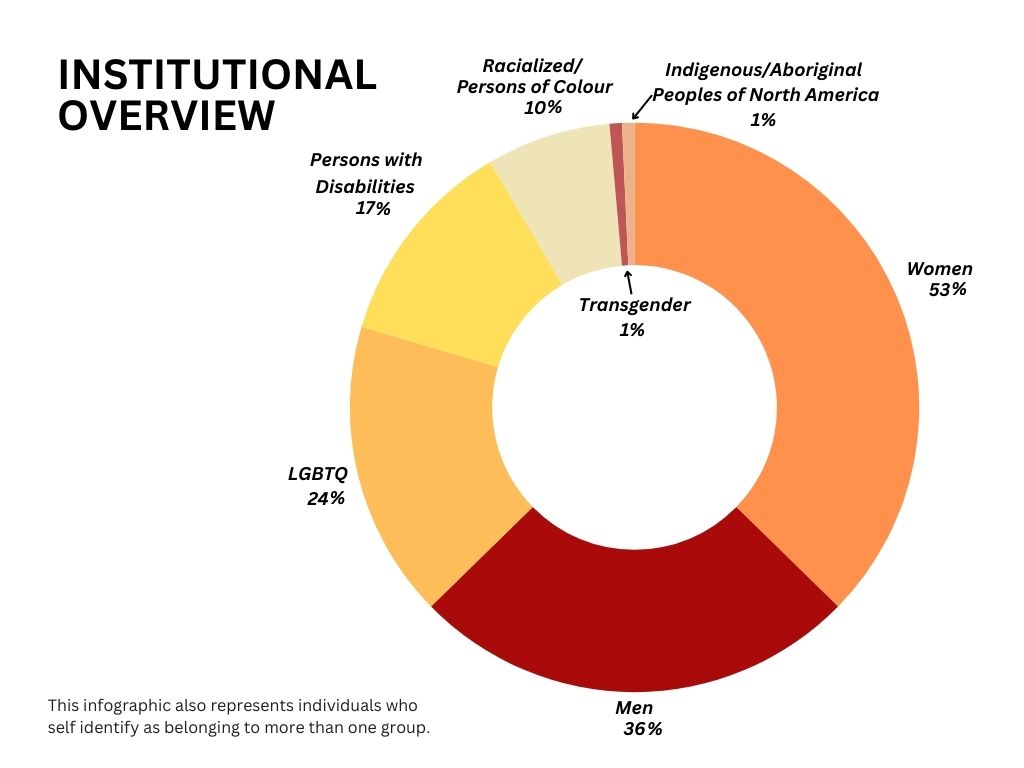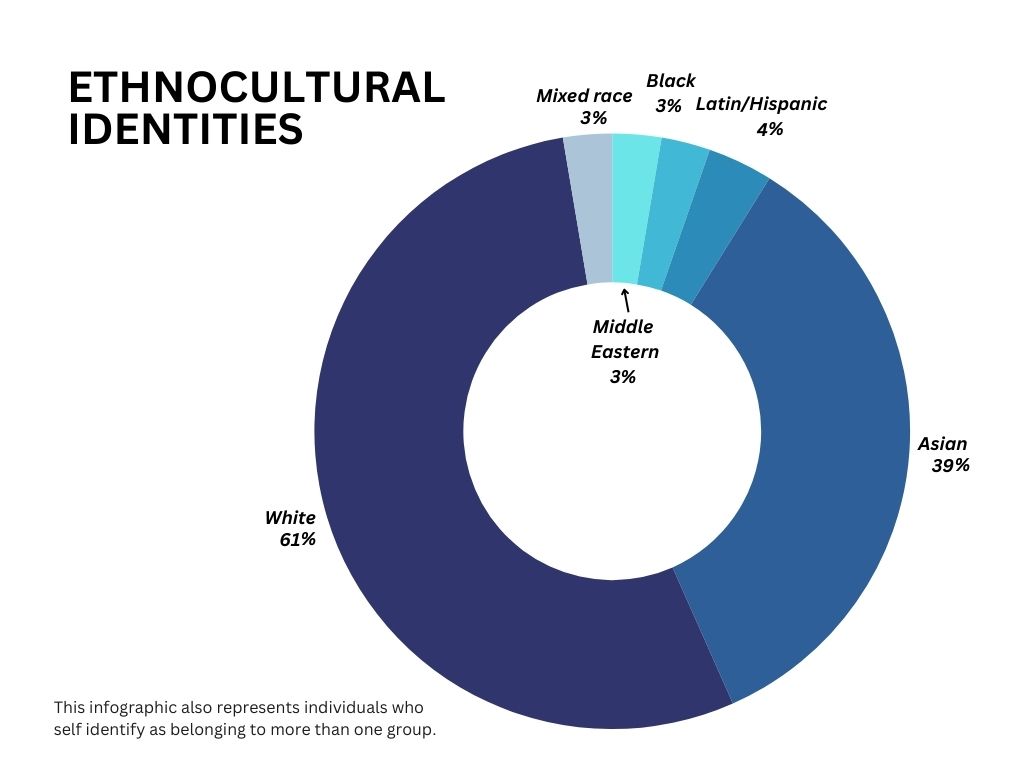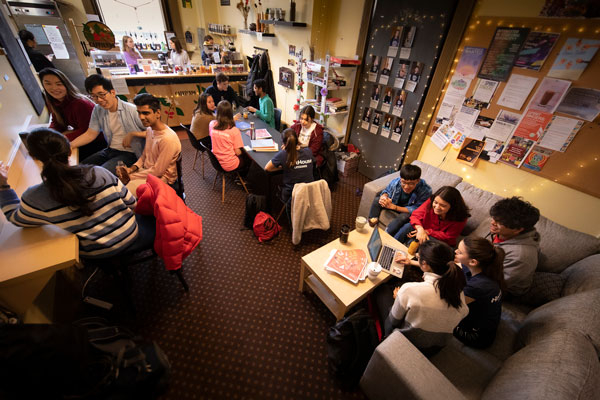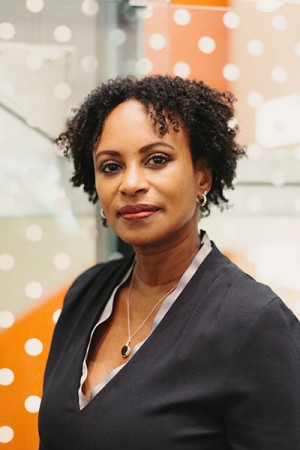Equity, Diversity, Inclusion and Accessibility at Victoria University
Victoria University is deeply committed to fostering Equity, Diversity, Inclusion and Accessibility across all aspects of campus life. As part of our five-year Strategic Framework, we have committed to fostering a strong sense of belonging by respecting and connecting the many voices, needs and histories of our members.
We believe that a truly vibrant community is one where everyone feels valued, respected and empowered to contribute their unique perspectives,” said Dr. Rhonda McEwen, President and Vice-Chancellor of Victoria University. “Diversity not only enriches our classrooms, programming and operations—it drives creativity and strengthens our collective ability to face challenges and shape a better future.”
Our Roadmap
The development of our EDIA Roadmap is guided by our dedication to creating a diverse and inclusive community that enriches the educational and social experiences of all members. We recognize that achieving equity and inclusion requires deliberate and thoughtful actions, and this plan will serve as our blueprint for driving meaningful change across the university.
Our approach to developing the EDIA Roadmap will be inclusive and collaborative, ensuring that the voices of students, faculty, staff, and external partners are integral to the process. Here is an overview of our plan:
- Consultation and Engagement: We will conduct extensive consultations with various stakeholders through surveys, focus groups, town hall meetings, and individual interviews. This will enable us to gather diverse perspectives, experiences and ideas that will shape our strategic priorities.
- Assessment and Analysis: We will perform a thorough assessment of our current EDIA practices, policies, and outcomes. This will include analyzing data on diversity metrics, reviewing institutional policies, and identifying existing gaps and barriers.
- Strategic Framework Development: Based on the insights gathered, we will develop a strategic framework that outlines our EDIA goals, objectives and initiatives. This framework will be aligned with the university’s broader mission and strategic priorities.
- Implementation Planning: We will create a detailed implementation plan, including timelines, responsibilities, and resource allocation. This plan will outline specific actions and initiatives to advance our EDIA goals, with clear milestones and accountability measures.
- Continuous Monitoring and Evaluation: To ensure the effectiveness and sustainability of our efforts, we will establish mechanisms for ongoing monitoring and evaluation. This will include regular progress reports, feedback loops and opportunities for continuous improvement.
Our EDIA Strategic Plan will focus on four key pillars:
- Equity: Ensuring fair treatment and equal opportunities for all members of our community, addressing systemic barriers and promoting social justice.
- Diversity: Embracing and celebrating the rich variety of backgrounds, identities and perspectives that each individual brings to our university.
- Inclusion: Creating a welcoming and supportive environment where everyone feels a sense of belonging and can fully participate in university life.
- Accessibility: Removing physical, technological, systemic and attitudinal barriers to ensure full participation of individuals with disabilities both physical/visible and less visible, such as neurodivergent individuals and those with chronic illnesses.
Workplace Employment Diversity Survey
Victoria University conducted its first workplace employment diversity survey of staff, faculty and librarians in the spring and summer of 2024 to help us better understand the makeup of our workforce.
It’s important to have this data so we know who is and is not represented on campus. Our staff, faculty and librarians should be diverse and inclusive and reflect our students and our surrounding community. We also want to ensure we are an inclusive and welcoming workspace and are developing initiatives to address any gaps in how we recruit, retain, promote and support our people.
This work is another step we are taking to fulfill our “Belonging” pillar of our Strategic Framework, although it also crosses into the other three pillars. Surveys like this are best practice when doing EDIA work and many Canadian universities have already done them, including the University of Toronto.
The survey asked questions about racial/ethnocultural identity, religious or spiritual affiliation, gender identity, sexual orientation and disability. We had a response rate of 38 per cent.



We will be reaching out in January to units that had a low response rate to raise awareness of why this data is important and give them another opportunity to complete the survey. If you have any questions about the survey or the findings, please reach out to vic.hr@utoronto.ca.
Scarborough Charter
Victoria University signed The Scarborough Charter on Anti-Black Racism and Black Inclusion in Higher Education: Principles, Actions, and Accountabilities in February 2024.
The charter, developed by the University of Toronto Scarborough in collaboration with Black communities, academic institutions and various institutional partners, is a commitment by institutions across Canada to combat anti-Black racism and foster Black inclusion in higher education. The charter recognizes the realities of anti-Black racism and includes concrete steps for action to ensure institutional and cross-sector accountabilities.
“The formal endorsement of the Scarborough Charter is another way that we are prioritizing this important work,” said Dr. Rhonda N. McEwen, president and vice-chancellor of Victoria University. “Vic U should be a place where every member of our campus feels that they belong, and as our surrounding communities in Canada grow, so do our desires to develop spaces where we learn from and with each other. We stand alongside our national colleagues who have endorsed the Charter to move toward a future where Black students, employees, faculty members, librarians and alumni feel that they have a voice and a place at Vic U.”

Accessibility and Accommodations
We are committed to providing supports, services and programs to help our students navigate any disability-related barriers.
You can also request religious-related accommodations as a student.

Equity and Diversity Initiatives
Click here to see the work we’ve done so far.
- DEAR Declaration by Emmanuel College
- Equity, Diversity and Inclusion in the Classroom
- Indigenous connections at Emmanuel College
- Indigenous Garden to Bloom at Emmanuel College
- Indigenous-Settler Relations and Collections: A Learning Series at Victoria University
- Reflections on Art & History event
- Presidential Report on the Legacy of Egerton Ryerson
- U of T’s Positive Space Campaign

Resources
Student Resources
Multi-Faith Resources
There are many interfaith and tradition-specific activities for students, staff, faculty and alumni to participate in.

Resources for Staff, Faculty and Librarians
Racial Equity Training
Ongoing education is fundamental to improving equity, diversity, inclusion, and belonging in the workplace. The BIPOC Executive Search firm offers our staff and faculty access to two key EDIA-related courses whose introductions can be found below:
To access these trainings, employees must login to Dayforce and navigate to the Learning section of their profile.
University Policies
- AODA – Built Environment and Public Spaces Policy
- AODA – Customer Service Policy
- AODA – Employment Policy
- AODA – Information and Communications Policy
- AODA – Multi-Year Accessibility Plan
Access to Alternate Formats: We strive to deliver services in an accessible manner. Please contact vic.hr@utoronto.ca for communications in alternative formats.
A Message From the President
 The research is clear: diverse communities achieve more, learn more and innovate more. We celebrate community a lot at Victoria University. Indeed, one of the core deliverables in our five-year Strategic Framework is to “…foster a strong sense of belonging within a supportive community by respecting and connecting the many voices, needs, and histories of its members. We commit to broadening and deepening this sense of belonging.”
The research is clear: diverse communities achieve more, learn more and innovate more. We celebrate community a lot at Victoria University. Indeed, one of the core deliverables in our five-year Strategic Framework is to “…foster a strong sense of belonging within a supportive community by respecting and connecting the many voices, needs, and histories of its members. We commit to broadening and deepening this sense of belonging.”
When we bring diverse experiences, histories and cultures to our classrooms, our student programming, our administrative tables and our operations, we get such an energizing range of ideas and perspectives. We can face obstacles and adapt to a changing world faster, and more creatively. We know that where diversity is absent there is a deficit of ideas. And at Vic U, we want to encourage and promote big ideas!
I have always been drawn to the definition of equity as being invited to the party, and inclusion as being asked to dance. There are so many exciting ideas in our community, and they will come to fruition only if we give everyone a chance to dance.
As someone who grew up in Trinidad and Tobago, I experienced a search for diversity that ran deeper than skin colour. It was often an exploration of worldviews informed by the history and experiences of the indigenous people and forced and voluntary immigrants. It invited us all to go below the surface and share more deeply with the people in our communities.
We often refer to this work as Equity, Diversity, Inclusion and Accessibility (EDIA). I personally use A JEDI – Accessibility, Justice, Equity, Diversity and Inclusion because it connects the value of equity, diversity and inclusion with accountability. (It also appeals to the Star Wars fan in me!) Whichever acronym we choose, it is clear that we are on an important journey together.
— Dr. Rhonda N. McEwen, President and Vice-Chancellor, Victoria University in the University of Toronto
